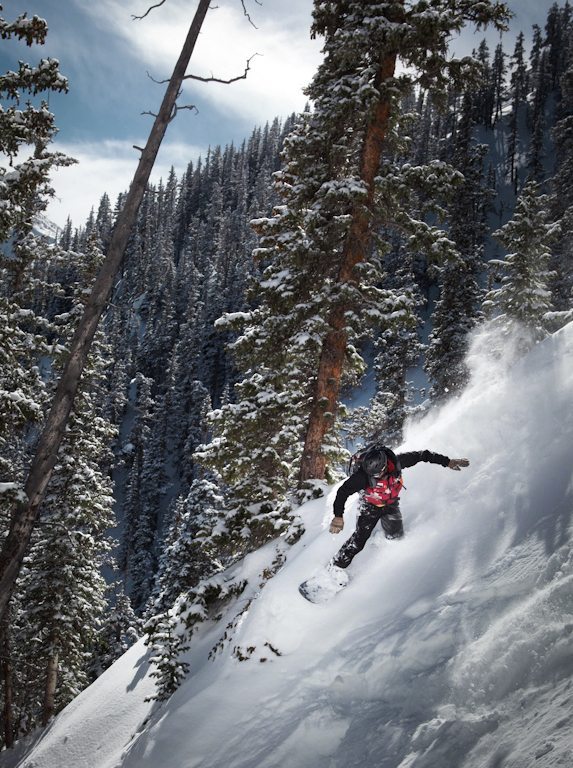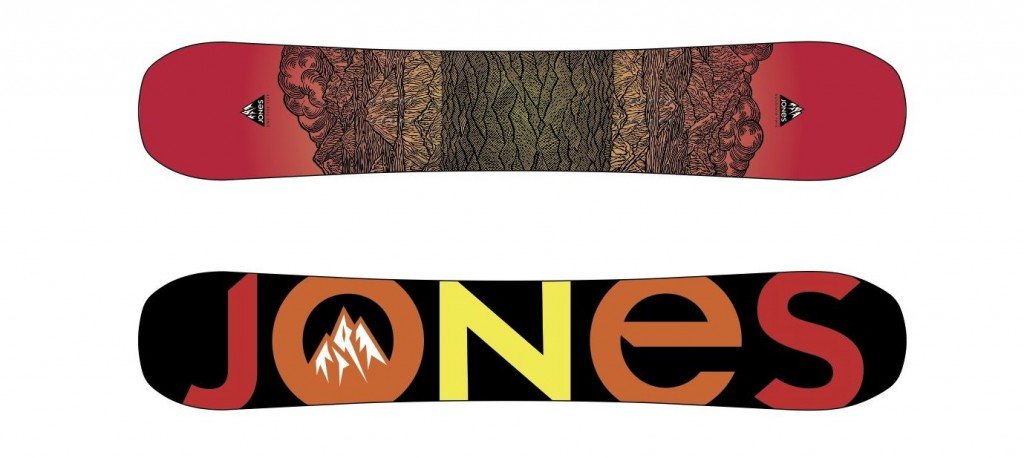Board: 2010-2011 Jones Snowboards Mountain Twin, 155cm
Dimensions (mm): Nose/Tail length: 215; Nose/Tail Width: 297mm; Waist width 252mm
Sidecut radius 7.3 mm
Boots / Bindings: K2 Thraxis / K2 Auto-Uprise
Test Locations: Taos Ski Valley, Arapahoe Basin, Independence Pass
Days Tested: 18
Jeremy Jones is a legend. Even as he hits his mid-thirties, Jones continues to set the curve for big mountain riding with films like Deeper, and his newest creation, Jones Snowboards. The main attraction of Jones Snowboards (JS) is obviously the name that works behind the scenes to create them. Despite being a young company (they launched their first boards in 2010), JS is attracting riders like Ralph Backstrom and Forrest Shearer, who view the entire mountain as a thrill-seeking zone.

Incredibly high demand for these boards meant that I had to wait a long time to get my hands on one. Normally, I would ride this board in a 159cm (the most appropriate size for my height and weight), but had to go with a 155cm due to availability.
I received the board on a late-February afternoon in Taos. I was excited, and I threw that enthusiasm into a seriously fast cruiser run. The first thing that really stood out was the weight of the board. It is very light (perhaps too light). The responsiveness and small size (for me) made it feel like a skateboard deck. Despite its light weight, I made a point to cut as deep into the icy February snow as I could, and it gripped very well. The board checked out amazingly by the bottom of the mountain.

For my second run I headed down Castor for some fast, steep moguls. The Mountain Twin performed well, quickly changing direction in the bumps. There were, however, a few moments where the twin shape messed with me and had me feeling like the tail was longer than the nose. I lean very deep onto the nose on the steeps, so the shortness left me pretty uneasy, like I was going to topple forward.
On my third run of the day, I started down St. Bernard, but my heel edge kept digging in and slamming me to the ground. I couldn’t figure out whether it was the nose shape digging, or the short length of the board. I continued down the run and attempted to ride switch, but every heel side turn sent me back into the ground. I figured it was a broken edge at worst. I got to the bottom, checked out the board, and saw that it had broken in half from the core right at the front binding. I’d certainly had no hard impacts or any encounters with rocks.
Bummed, I shrugged it off and put it back in the mail the same day I got it.
I spoke with Josh at Jones Snowboards and he confirmed the event to be a manufacturer defect. They had only a few reports of defective boards this year, and were quick to warranty it for a new one.
All companies have defects now and then, and it’s good to know which companies will take care of you.
When I got the second board, the real tests began. The board is a true twin-shape, but has varying flex strength from tail to nose. The nose of the board is a bit softer, which allows for dampening frontal impacts. On the other end, the stiffer tail worked really well in generating pop and enabled quick recoveries.
But the Twin’s shape was not the most suitable for me. I constantly felt like there was more board behind me than in front, which feels counter-intuitive. I measured the distances, and it turned out that my stance actually was allowing for more length in front than in back, so the feeling of a short nose / long tail might be chalked up to the relatively short length of the board….
The nose and tail have a blunt, almost flat shape to them. I couldn’t figure out the main reason for this attribute other than to direct the spray outward during powder shredding, but I did find one unexpected benefit of this design: I was hiking with the board on Independence Pass on June 7th and found the flat nose to be very beneficial while using the board as a walking stick. Furthermore, the flat edge was useful, too, for boot packing, since you can dig the board into the snow for added stability.
The board is equipped with what Jones Snowboards and Nidecker, who makes JS, call Camrock. Simply put, it’s the combination of rocker and camber, with camber under the binding inserts and rocker at the tip and tail. Out of all the combinations of varying cambers and rockers, this one seems to make the most sense to me, and allows a longer board to serve the function of a smaller, regular-cambered board. Again, the 155cm length was just a tad too short to be super effective for how I wanted to ride it, but it still performed well enough to reveal the board’s benefits.

When I received the replacement board from Jones, we were in spring conditions, so that’s the environment in which I did most of the testing of the Mountain Twin. As far as icy mornings and slushy afternoons go, this board was as playful as any other I’ve been on, if not more. Great pop and responsiveness. In April, slushy moguls at Taos and down The Spine and Exhibition at A-basin were super fun on this board. It performed well in the park, but bouncing around down the mountain kept me the most entertained.
At the beginning of June I spent a few days at Independence Pass, hiking and hitch-hiking runs. Throughout the time, I didn’t really notice JS’ Magne-Traction (designed for superior edge hold) providing a noticeable improvement over a board without it.
As I mentioned, this particular board was a little small for me, and was easy to turn solely due to its size. However, while it was easy to turn, it didn’t feel squirrely or have a detrimental effect on the board’s performance.

All in all, the Jones Mountain Twin is a promising board that, with a few tweaks, could be a phenomenal board (The 2012 board will feature carbon to “tighten up the flex and dampen the ride,” according to JS). It needs to be built stronger. I didn’t have any run-ins with rocks or trees, but imagine that a small hit could be devastating. I grew to like the overall shape of the board and found the twin style to be very playful and practical for all types of riding, with the exception of really steep, deep lines.
Graphic design is the least important of a board’s characteristics, but the Mountain Twin has a great look to it. The design of the board is based on the natural look of the wood it’s made from, and highlights the poplar and beech core (The look will change for 2012. See Above). The top sheet is made of a film to lighten the board, but is easily scratched .
I’m eager to delve deeper into the Jones Snowboards lineup next season and test their split board (The Solution). Of course, their big mountain board, The Flagship, looks really sweet, too….
We’ll be sure to let you know.

How did you go about getting warranty info from jones snowboards?